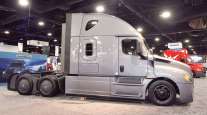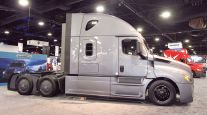Staff Reporter
March Class 8 Sales Up 21.9% to 24,823

[Stay on top of transportation news: Get TTNews in your inbox.]
U.S. Class 8 retail sales in March jumped 21.9% from a year ago and also exceeded the prior month, Wards Intelligence reported.
Class 8 sales for the month reached 24,823 units compared with 20,359 in 2022, and outpaced February’s 20,136. Truck retail sales have increased every month since they dropped from a record-high 29,172 units in December.
“We were pleasantly surprised,” ACT Research President Steve Tam said. “Good to see that we’re finally making a little bit of progress. Honestly, the strength of sales hearkens back to what we saw in the January and February time frame with increased production. If you don’t build it, you can’t sell it. And so, we’re slowly but surely, I think, putting supply chain constraints into the rearview mirror.”
Tam noted that the year-over-year gain is slightly above where it typically would be from a seasonal perspective. But he points out that, despite the progress, parts allocation is still an issue for manufacturers.

Tam
“They’re still not going to get as many pieces and parts as they would like to get or as their customers would like them to get,” Tam said. “But the deficit is shrinking, thankfully.”
Tam noted that while carriers have continued to do well financially, they also have also indicated in recent quarterly earnings reports that they are anticipating a slowdown this year. But this should only result in a marginal pullback to replace aging trucks, he pointed out, since so many already have been pushed well past when they would normally be replaced.
“They’re not going to pull back as much as they would under other conditions, so there should still be a pretty decent market,” Tam said. “Our U.S. Class 8 forecast for this year, we did not change it this month, so we’re still expecting sales of, let’s just call it, 260,000. So that’s down just a squish from where we were last year, but it’s at or above replacement.”
Tam noted the vast majority of orders this year will go toward replacing aging trucks as opposed to fleet growth. He doesn’t expect a significant slowdown in production and sales to start until the fourth quarter and going into 2024.

Kriete
“Sales [demand] continues to outpace supply in a major way,” said David Kriete, president of Kriete Truck Centers. “Factory constraints are still affecting all manufacturers, and as such anticipated build slots are moving a bit, but much more stable than 12 and 24 months ago. Interestingly, the vocational/construction side of the business remains the most strong, however almost all trucks in these segments require additional bodies and equipment.”
Kriete added the truck manufacturers themselves aren’t the only constraint in the build process with body companies increasing their turnaround time on new truck upfits. He noted that in some cases they are pushing out over 16 months.
“All in all, March was another strong month for our brands, our customers and our business partners,” Kriete said. “I anticipate this will continue for another quarter at least.”
Freightliner, a brand of Daimler Truck North America, again led the pack with 9,208 trucks sold, accounting for a market-leading 37.1% share. Navistar experienced the largest year-over-year increase as sales of its International brand jumped 77.7% to 4,154 units from 2,338.
Six of the seven major truck manufacturers posted gains over the prior year. Kenworth Truck Co.’s sales increased 12.5% to 3,359 from 2,987, while Peterbilt Motors Co. sales grew 6% to 3,432 from 3,239. Both are brands of Paccar Inc.

Anthony Marshall of UPS shares the gold standard for an efficient and effective EV maintenance cycle. Hear the program above and at RoadSigns.TTNews.com.
“We had a weaker March than what we had hoped for, particularly in the U.S. where we had a 9.3% market share,” said Magnus Koeck, Volvo Trucks’ vice president of strategy, marketing and brand management. “On the other hand, we did well in Canada with a 14.7% market share. Year-to-date we are not where we want to be with a 9.7% share for U.S. and Canada combined. We are still facing some supply chain challenges, but the focus will need to be on a strong second quarter as we need to build some momentum back up from a slower-than-expected start to the year.”
Mack Trucks’ sales grew 38.6% to 1,727 from 1,246, and Volvo Trucks North America’s increased 5.1% year-over-year to 2,313 from 2,200. Mack and VTNA are brands of Volvo Group.
“Preliminary sales data show that HD sales in the first quarter are on track for a 28% [year-over-year] increase in the U.S. and Canada,” Mack Trucks North America President Jonathan Randall said. “Our sales improved at a greater rate than the market in the same period as we continue our relentless focus on supply chain optimization and delivery to our customers. The demand is still strong as customers replace their aging fleets and we work through our order bank.”
Western Star, a Daimler brand, saw a 7.3% decrease in sales to 610 from 658.
In addition, Tesla sold 20 of its Class 8 Semi electric trucks.
Want more news? Listen to today's daily briefing below or go here for more info:




